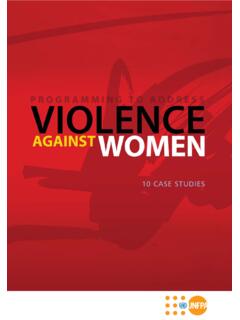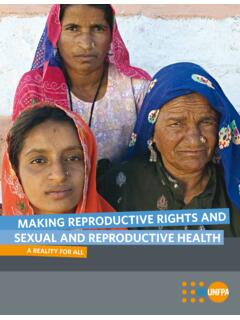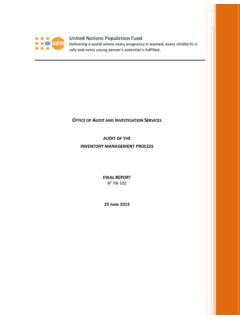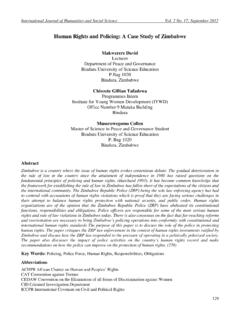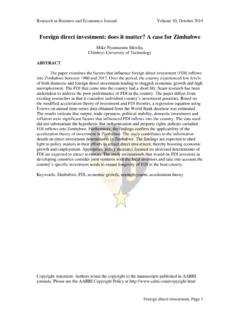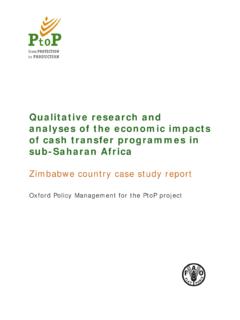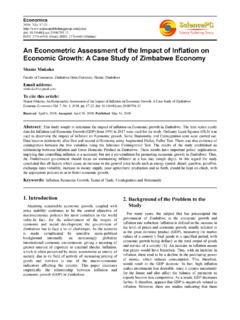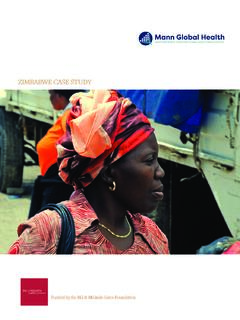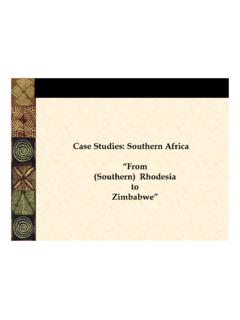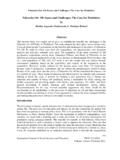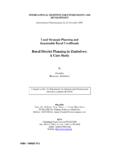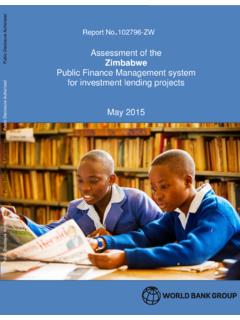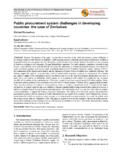Transcription of EVALUATION OF UNFPA SUPPORT TO FAMILY PLANNING …
1 country NOTE EVALUATION OF UNFPA SUPPORT TO FAMILY PLANNING 2008-2013 country case study zimbabwe _____ EVALUATION OFFICE AUGUST 2015 EVALUATION of the UNFPA SUPPORT to FAMILY PLANNING Services 2008-2013 zimbabwe case study Note EVALUATION Manager: Louis Charpentier EVALUATION Office UNFPA Reference group members: 1 Maha El Adawy UNFPA ASRO 2 Nestor Azandegbe UNFPA WCARO 3 Elizabeth Benomar UNFPA Technical Division, HIV and AIDS Branch 4 Louis Charpentier UNFPA EVALUATION Office Chair 5 Rita Columbia UNFPA Technical Division, Commodity Security Branch 6 Ezizgeldi Hellenov UNFPA EECARO 7 Desmond Koroma UNFPA Technical Division, Commodity Security Branch 8 Laura Laski UNFPA Technical Division, Sexual and Reproductive Health Branch 9 Shawn Malarcher USAID Office of Population and Reproductive Health Bureau for Global Health 10 Farah Usmani UNFPA Programme Division, Operational SUPPORT & QA Branch 11 Josiane Yaguibou UNFPA ESARO 12 Selen rs UNFPA EVALUATION Office/Programme Coordinator Turkey country Office- Ankara Euro Health Group (EHG) EVALUATION Team.
2 1 Lynn Bakamjian Burkina Faso case study team leader 2 Meg Braddock Overall EVALUATION team leader 3 Thenjiwe Masuku National Consultant Copyright UNFPA 2016, all rights reserved. The analysis and recommendations of this report do not necessarily reflect the views of the United Nations Population Fund. This is an independent publication by the EVALUATION Office of UNFPA . A multicultural team of international and national experts authored this report. The report has been quality assured, including extensively fact-checked, by the UNFPA EVALUATION Office and the UNFPA country Office in zimbabwe . The findings have been found to be sound and credible by the UNFPA EVALUATION Office. The report has not, however, been subject to a professional copy edit or systematic editorial checks and may therefore vary in editorial quality. Any enquiries about this report should be addressed to: EVALUATION Office, United Nations Population Fund, e-mail: For further information on the EVALUATION please consult the EVALUATION Office webpage: i TABLE OF CONTENTS ABBREVIATIONS AND ACRONYMS.
3 1 INTERVENTION MAP .. 4 KEY FACTS zimbabwe .. 5 1 INTRODUCTION .. 5 Objectives of the EVALUATION .. 6 Scope of the EVALUATION .. 6 Overview .. 7 Structure of the country note .. 8 2 METHODOLOGY .. 8 Selection of country case 8 Selection of zimbabwe as a case study .. 9 Scope of the study and data collection methods .. 9 3 SHORT DESCRIPTION OF FAMILY PLANNING IN zimbabwe .. 11 4 FINDINGS .. 17 Integration of FAMILY PLANNING with other SRH services .. 17 Coordination and National Ownership .. 21 Brokerage and partnerships .. 22 Enabling Environment .. 24 Vulnerable and marginalised populations .. 26 Human rights-based approach .. 28 Different modes of engagement .. 30 Supply-side activities .. 32 5 CONCLUSIONS .. 33 UNFPA has integrated FAMILY PLANNING within Sexual and Reproductive Health policy and service provision, although missed opportunities exist for integration of FP within maternity services.
4 33 Effective coordination and brokering advanced government action for FAMILY PLANNING , yet challenges remain for national ownership and sustainability .. 34 Enabling environment, supply side and demand creation activities contribute to increased FAMILY PLANNING availability and use .. 34 UNFPA has contributed to addressing the needs of vulnerable and marginalised populations, gender-based violence prevention and response, as well as human rights, although results are not well-documented .. 35 Strategic programming and use of modes of engagement are appropriate for the country context 35 Lack of results-oriented monitoring and EVALUATION system affect UNFPA capacity to assess results of its SUPPORT .. 35 ANNEX 1 BIBLIOGRAPHY .. 37 ANNEX 2 LIST OF PEOPLE 41 ANNEX 3 EVALUATION MATRIX .. 43 ii ANNEX 4 SRHR AND FAMILY PLANNING EXPENDITURE (2008-2013).
5 88 ANNEX 5 IMPLEMENTING PARTNERS .. 95 ANNEX 6 KEY FACTS, EXPANDED TABLE .. 98 Figure 1: SUPPORT to FAMILY PLANNING by Implementing Sectors (2009 2013) (US$) .. 16 Figure 2: SUPPORT to FAMILY PLANNING by Implementing Sectors Total 2008-2013 .. 16 Table 1: Strategic documents related to FAMILY PLANNING .. 13 1 ABBREVIATIONS AND ACRONYMS AIDS Acquired Immune Deficiency Syndrome AfriYAN African Youth and Adolescent Network ANC Ante-natal care ART Antiretroviral therapy ASRH Adolescent sexual and reproductive health BCC Behaviour change communication BCF Behaviour Change Facilitator CaCx Cervical cancer CBD Community-based distribution CBO Community-based organization CCP Comprehensive condom programming CO UNFPA country Office COAR country Office Annual Report CP country Programme CPD country programme document CPE country Programme EVALUATION CPR Contraceptive Prevalence Rate CSO Civil Society Organisation CSW Commercial sex workers CYP Couple Years of Protection DFID Department for International Development (United Kingdom)
6 DHO District Health Office DHS Demographic Health Survey DP Development Partners DTTU Delivery Team Topping Up system ESARO UNFPA East and Southern Africa Regional Office FGD Focus Group Discussion FHI FAMILY Health International FP FAMILY PLANNING FP2020 FAMILY PLANNING 2020 FSW Female Sex Worker GBV Gender Based Violence GDP Gross domestic product GF Global Fund to Fight AIDS, Tuberculosis and Malaria GII Gender inequality index GNP Gross National Product GoZ Government of zimbabwe GPRHCS Global Programme for Reproductive Health Commodity Security 2 HCT HIV Counselling and Testing HCW Health Care Worker HDI Health development index HIV Human Immunodeficiency Virus HQ UNFPA Headquarters HRBA Human Rights Based Approach HTF Health Transition Fund ICPD International Conference on Population and Development IEC Information, Education and Communication INGO International Non-Government Organisation IP Implementing Partner IPPF International Planned Parenthood Federation ISP Integrated SUPPORT Programme IU(C)D Intra-Uterine (Contraceptive) Device JSI John Snow, Inc (US health NGO) KII Key Informant Interview LAM Lactational Amenorrhea Method LA/PM Long-acting and permanent methods of contraception LARC Long-acting reversible contraceptives MCH Mother and child health MCHIP Maternal and Child Health Integrated Project (USAID)
7 MCPR Modern Contraceptive Prevalence Rate MDG Millennium Development Goals MISP Minimum integrated service package MMR Maternal mortality rate MNCH Maternal neonatal and child health MNH Maternal and Neonatal Health MoHCC Ministry of Health and Child Care MSI Marie Stopes International MSM Men who have sex with men MWACD Ministry of Women s Affairs, Gender and Community Development NAC National AIDS Council NatPharm National Pharmaceutical Company of zimbabwe NGO Non-Government Organisation OC Oral Contraceptives OI Opportunistic Infections OR Operational Research PEPFAR (US) President s Emergency Plan for AIDS Relief PLWHIV People Living with HIV PMD Provincial Medical Directorate PMTCT Preventing mother to child transmission (of HIV) 3 PNC post-natal care PPFP Postpartum FAMILY PLANNING PSI Population Services International PSZ Population Services zimbabwe (Marie Stopes International affiliate)
8 QA Quality Assurance RBA Rights based approach RBF Results-based financing RH Reproductive Health RHCS Reproductive Health Commodity Security RMNCH Reproductive Maternal Neonatal and Child Health RO UNFPA Regional Office SDP Service Delivery Point SRH Sexual and Reproductive Health SRHR Sexual and Reproductive Health and Rights STI Sexually transmitted infection TA Technical Assistance ToC Theory of Change ToR Terms of Reference ToT Training of trainers UNFPA United Nations Populations Fund UNICEF United Nations International Children s Emergency Fund USAID United States Agency for International Development VIAC Visual inspection with acetic acid and cryotherapy VMG Vulnerable and Marginalised Group WHO World Health Organisation YFS Youth friendly services ZIM-ASSET zimbabwe Agenda for Sustainable Socio-Economic Transformation ZIMSTAT zimbabwe National Statistics Agency ZLHR zimbabwe Lawyers for Human Rights ZNFPC zimbabwe National FAMILY PLANNING Council 4 INTERVENTION MAP 5 KEY FACTS zimbabwe Indicator 2014 Source of Data Population and Development Population, total 15,245,855 World Bank1 Population growth (annual %) World Bank1 Urban Population (% of total) 33 World Bank1 Population Density (per sq.)
9 Km of land area) 39 World Bank1 Life Expectancy at birth, total (years) 56 (2013 data) World Bank1 Literacy rate, population 15+ years (%) - World Bank1 Human Development Index (HDI) (Rank 155 out of 188) Human Development Report2 Economic growth rate (GDP growth annual %) World Bank1 GINI Index - World Bank1 Gender Equality and Empowerment Gender Inequality Index (Rank 112 out of 155) Human Development Report3 Women representation in parliament, total (%) 32 World Bank1 Violence against women ever experienced (%) Human Development Report3 Employment to population ratio, 15+, female (%) (modeled ILO estimate) 79 Human Development Report5 Ratio of girls to boys in primary and secondary education (%)4 - World Bank1 Reproductive Rights and Reproductive Health Adolescent fertility rate (births per 1,000 women ages 15-19) 110 World Bank1 Teenage mothers (% of women ages 15-19 who have had children or are currently pregnant) - World Bank1 Prevalence of HIV, both sexes (% ages 15-49) World Bank1 Maternal mortality rate (per 100,000 live births) 401 World Bank1 Under 5 mortality rate (per 1,000 live births) 72 World Bank1 Contraceptive use, modern methods (% ) UN DESA5 Unmet need for FAMILY PLANNING (%) UN DESA6 Births attended by skilled health staff (% of total) - World Bank1 1 World Bank.
10 (2016). zimbabwe . Retrieved from 2 United Nations Development Programme. (2016). zimbabwe . Retrieved from 3 United Nations Development Programme. (2016). Table 5: Gender Inequality Index. Retrieved from 4 This indicator is also labeled as Gross enrolment ratio, primary and secondary, gender parity index (GPI) by the World Bank. 5 United Nations. (2016). UN DESA Population Division Estimates and Projections of FAMILY PLANNING Indicators. Retrieved from 6 1 INTRODUCTION FAMILY PLANNING (FP) is a principal focus of the work of UNFPA worldwide. This country case study is part of a thematic EVALUATION of UNFPA SUPPORT to FAMILY PLANNING 2008-2013, whose objective is to assess progress against past and current strategic plans and inform future decision-making and policy formulation in FAMILY PLANNING . Objectives of the EVALUATION Purpose The purpose of the EVALUATION is to assess the performance of UNFPA in the field of FAMILY PLANNING during the period covered by the Strategic Plan 2008-2013 and to provide learning to inform the implementation of the current UNFPA FAMILY PLANNING Strategy Choices not Chance (2012-2020).
